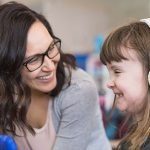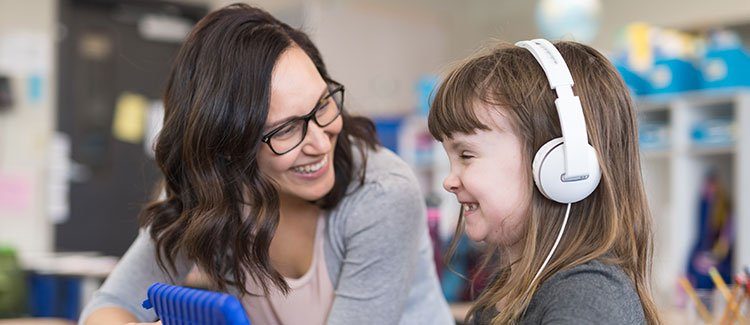Kids with learning and attention issues often face barriers to learning. For instance, if your child has ADHD, she may not be able to sit still long enough to do math problems. If she has reading issues, she may struggle to learn history from a traditional textbook. Fortunately, there are changes in the classroom — called accommodations — that can remove these barriers.
Read on to learn more about what accommodations are and how they can help your child.
What accommodations are
Accommodations are changes that remove barriers and provide your child with equal access to learning. Accommodations don’t change what your child is learning. Rather, they change how your child is learning.
Here’s a classic example. Let’s say your child is taking an American history class, but she struggles with reading. As an accommodation, the teacher lets her listen to an audiobook version of the textbook.
By using an audiobook, she can learn history without her reading issues getting in the way. This has removed a barrier to her learning.
Accommodations don’t change what your child is expected to know or learn. They don’t lower expectations. Your child may use an audiobook in American history, but she’s still expected to learn about events like the Civil War. And she still must complete all assignments and take exams, just like her peers. The accommodation simply helps her work around her challenges.
This is what makes accommodations different from modifications. A modification changes what your child is expected to know or learn. In American history, for instance, a modification may be that a child only needs to learn half of the material in the textbook.
Types of accommodations
Accommodations work best when they target a specific barrier or challenge. For instance, for the child who can’t sit still to do math, an accommodation may be frequent breaks. For the child who struggles to write out answers on tests, an accommodation may be to have her give answers orally. The accommodation matches the need.
Here are four categories of accommodations for different needs:
- Presentation: A change in the way information is presented. Example: Letting a child with dyslexia listen to audiobooks instead of reading printed text. (See more classroom accommodations for dyslexia.)
- Response: A change in the way a child completes assignments or tests. Example: Providing a keyboard to a child who struggles with handwriting when she’s writing an essay. (See more classroom accommodations for kids who struggle with writing.)
- Setting: A change in the environment where a child learns. Example: Allowing a child with ADHD to take a test in a separate room with fewer distractions. (See more classroom accommodations for ADHD.)
- Timing and scheduling: A change to the time a child has for a task. Example: Providing extra time on homework for a child who has slow processing speed. (See more classroom accommodations for slow processing speed.)
How to get accommodations for your child
If you think accommodations may help your child, talk to her teacher. Often, the teacher may agree to informal supports. These simple changes don’t require paperwork. It doesn’t take much, for example, for the teacher to move your child’s seat away from a noisy classroom door that’s distracting.
If your child needs bigger changes, however, you may want to seek formal accommodations. Under federal law, kids with disabilities have the right to equal access to learning. This means accommodations for their disabilities, which can include learning and attention issues. To exercise this right, you must ask the school to evaluate your child.
The evaluation can lead to an IEP or a 504 plan for your child. You and the school decide together what accommodations to write into the plan. By law, this must also cover any accommodations on state tests. (Learn about the difference between IEPs and 504 plans.)
Just because an IEP or a 504 plan lists accommodations, however, doesn’t mean they’re always followed in the classroom. It’s still important to check in with the teacher. And it’s important to talk with your child about how the accommodations are working.
Schools are usually open to providing accommodations. The bigger challenge is choosing the right accommodations and keeping track of which ones are most helpful.
If an accommodation is in place, but your child isn’t using it, find out why. Also, if your child gets accommodations on state tests, it’s important for her to use them regularly in class. This helps her get familiar with the accommodations.
Accommodations outside the classroom
Learning and attention issues don’t just create challenges in school. They also affect everyday life. That’s why accommodations also exist outside the classroom. But instead of providing an equal opportunity to learn, they provide an equal opportunity to participate.
Accommodations can apply to many activities. You may see them used in driver’s tests, the workplace, summer camps, sport clubs and even at Disney World.
Some of these accommodations are provided informally. Often, though, there’s a specific process you need to follow to get them. Outside of school, kids with disabilities have a legal right to reasonable accommodations. To learn more, read how the Americans with Disabilities Act protects your child.
Accommodations can be a powerful tool for helping your child by removing barriers to learning. Learn more:
- Find out how to tell if your child’s accommodations are working.
- Explore accommodations for specific learning and attention issues.
- See a list of surprising IEP and 504 plan accommodations.
Key takeaways
- Accommodations are important tools for removing barriers in school and beyond.
- Kids with learning and attention issues may have a legal right to accommodations.
- Looking at lists of common accommodations can help you think about what might help your child.
Content provided by: Understood.org.






